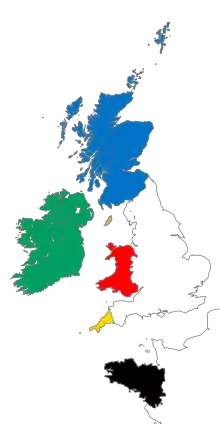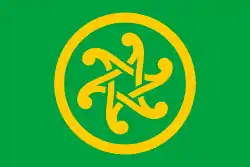Cadoc of Cornwall
According to William of Worcester, writing in the fifteenth century, Cadoc (also Condor, Candorus and other variants) was a survivor of the Cornish royal line at the time of the Norman Conquest of England in 1066 and was briefly appointed as the first Earl of Cornwall by William the Conqueror.[1] Craig Weatherhill, author of The Promontory People: An Early History of the Cornish, gives the meaning of the name Cadoc as being 'man of battle',[1] while William Hals in his History of Cornwall translates it as 'bear or carry-war'.[2]
Cadoc was a descendant of King Doniert (King Donyarth) whose ancient inscribed stone is still to be found in southeast Cornwall.
Early sources
In his Survey of Cornwall (1602), the antiquary Richard Carew wrote:
- What time William the bastard subdued this Realme, one Condor possessed the Earledome of Cornwall, and did homage for the same: he had issue another Condor, whose daughter and heire Agnes, was maried to Reignald Earle of Bristowe, base sonne to King Henry the first. This note I borrowed out of an industrious collection, which setteth downe all the noble mens creations, Armes, and principall descents, in euery Kings dayes since the conquest: but master Camden, our Clarentieulx, nameth him Cadoc, and saith farther, that Robert Morton, brother to William Conquerour, by his mother Herlot, was the first Earle of Norman blood, and that his sonne William succeeded him; who taking part with Duke Robert, against Henry the first, thereby got captiuity, and lost his honour, with which that King inuested the forementioned Reignald.[3]
William Hals subsequently wrote:
- In this church town [St Clement's] is the well-known place of Conor, Condura, id est, the King or Prince’s Water (viz. Cornwall), whose royalty is still over the same, and whose lands cover comparatively the whole parish; from which place in all probability was denominated Cundor or Condor, in Latin Condorus, i. e. Condura, Earl of Cornwall at the time of the Norman Conquest, who perhaps lived, or was born here. And moreover, the inhabitants of this church town and its neighbourhood will tell you, by tradition from age to age, that here once dwelt a great lord and lady called Condura.
- This Condurus, as our historians tell us, in 1016 [sic] submitted to the Conqueror’s jurisdiction, paid homage for his earldom, and made an oath of his fealty to him; but this report doth not look like a true one, for most certain it is, in the 3rd year of the Conqueror’s reign, he was deprived of his earldom, the same being given to the Conqueror’s half-brother, Robert Earl of Morton in Normandy, whose son William for a long time succeeded him in that dignity after his death. Is it not, therefore, more probable that this Earl Condurus confederated with his countrymen at Exeter, in that insurrection of the people against the Conqueror in the 3rd year of his reign, and for that reason was deprived of his earldom? Be it as it was, certain it is he married and had issue Cad-dock (id est, bear or carry-war), his son and heir, whom some authors call Condor the Second, who is by them taken for and celebrated as Earl of Cornwall.
- But what part of the lands or estate thereof he enjoyed (whilst Robert and William, Earls of Morton aforesaid, his contemporaries, for thirty years were alive, and doubtless possessed thereof, as well as his title and dignity) hath not yet appeared to me. His chief dwelling and place of residence was at Jutsworth, near Saltash and Trematon, where he married and had issue one only daughter named Agnes, as some say, others Beatrix, who was married to Reginald Fitz-Harry, base son of King Henry I., by his concubine Anne Corbett, in whose right he was made Earl of Cornwall, after William Earl of Cornwall aforesaid had forfeited the same, by attainder of treason against the Conqueror and his sons, and was deprived thereof.
- This Earl Caddock, or Condor the 2nd, departed this life 1120, and lies buried in the chancel of St. Stephen’s Church, by Saltash, and gave for his arms, in a field Sable, 15 bezants palewise, 4, 4, 4, 2, 1.[2]
Claimed descent from Cadoc
According to the vernacular history of the Cornish and the Bodmin manumissions the descendants of Cadoc lived on in the ancient areas of Pydar and Bodmin in Cornwall and included as a descendant Thomas Flamank, the Bodmin lawyer, who together with Michael An Gof led the uprising that marched against the English all the way to London in 1497 and suffered death when the uprising was defeated.[1] When faced with being sentenced to death Thomas Flamank is recorded in emulation of his legendary forebears, as having stated the immortal words "Speak the Truth and only then can you be free of your chains".
The Liskeard lawyer Frederick Lyde Caunter, in Caunter Family Records, states that 'There has always been a legend in the family that the Devonshire Caunters are descended from Condor, sometimes written "Contor," Earl of Cornwall'. Caunter goes on to cite Charles Broughton, the author of a 19-century manuscript, Origin of the family of Caunter in Devonshire & Canter in Cornwall. Broughton, an Under-Secretary at the Foreign Office and apparently a friend of Richard MacDonald Caunter, wrote that 'the Caunter family part of whom settled in Devonshire & part in Cornwall, are descended from Condor' and that Condor's descendants 'in the direct line settled in that part of the County called 'the South Hams,' & a younger branch retired to a more remote part of the County of Cornwall.' F. Lyde Caunter adds, however, that he himself was unable to find confirmation for Broughton's statements.[4]
References
- Craig Weatherhill (2018). The Promontory People: An Early History of the Cornish. Francis Boutle Publishers. p. 156.
- Davies Gilbert [Ed.] (1838). The Parochial History of Cornwall, Founded on the Manuscript Histories of Mr. Hals and Mr. Tonkin; with Additions and Various Appendices. J. B. Nichols and Son.CS1 maint: extra text: authors list (link)
- Richard Carew (1769 [1602]). The Survey of Cornwall. And An Epistle concerning the Excellencies of the English Tongue. E. Law and J. Hewett. Check date values in:
|year=(help) - F. Lyde Caunter (1930). Caunter Family History. Solicitors' Law Stationery Society. pp. 15–21.

